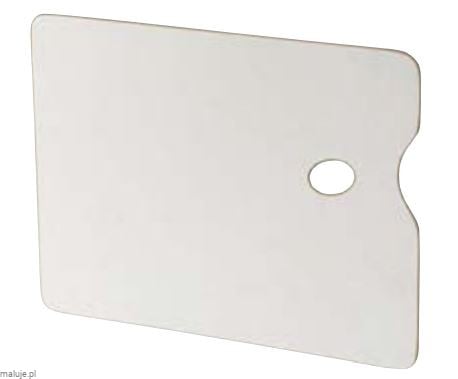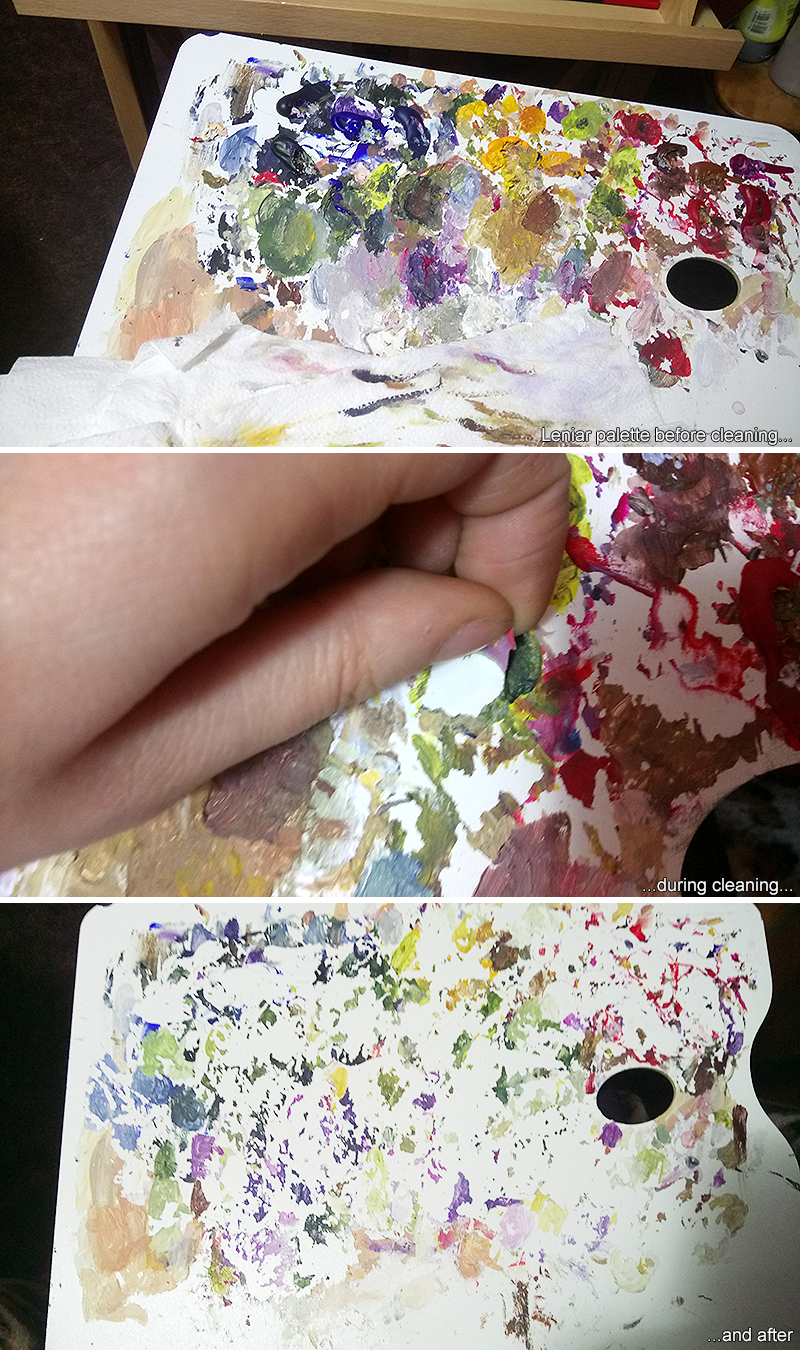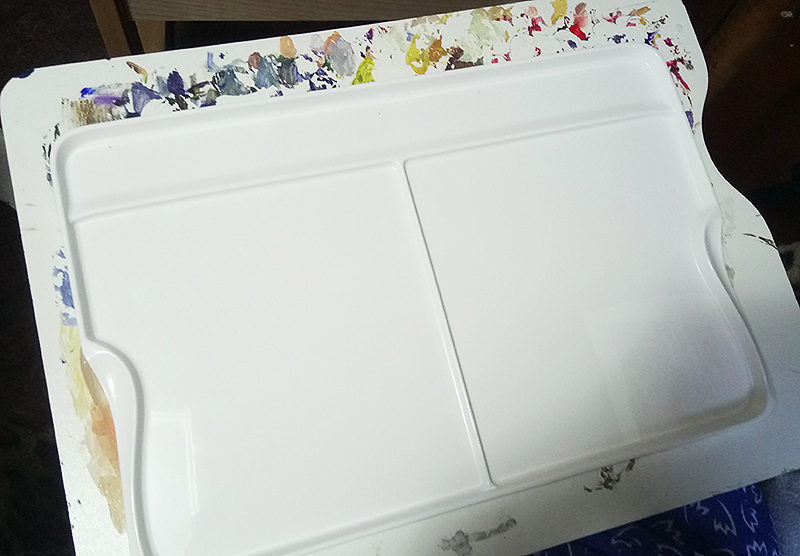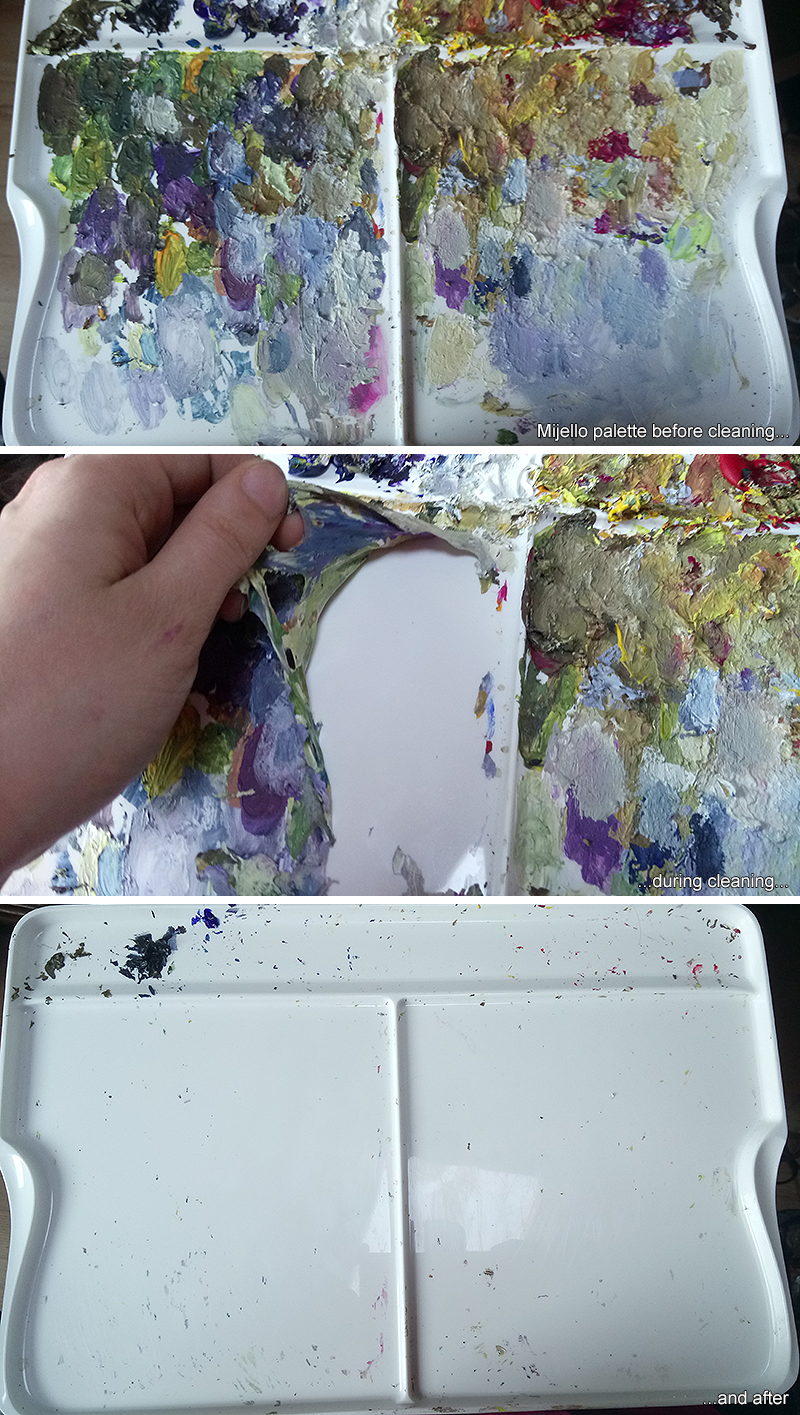Testing new Mijello Peel-off palette
First art post after a long while! I really missed it.
As some of you may know – one of my favourite traditional art media is acrylic paints. Just like any other paints you have to have a place to keep and mix this medium while painting – a palette. Most of the traditional artists I know paint either with oils or watercolours, so many things about acrylics I have to discover on my own, including what palette is the best for acrylics and which one I like the most.
The first palette I was using was a cheap watercolor plastic palette, the kind you can buy in supermarkets (and I believe that’s where I got mine) with round-ish shape, recesses for paints and a hole for a thumb. It was way too small for my needs so using it was a constant struggle and I was told by my painting master that this kind of palette is a big no and that I should change it.
So my next palette was a big (bigger than A3) wooden clipboard with a sheet of paper on it. After a while it got to me that paper is just too grainy and it absorbs water pretty fast so my paints were drying too quickly. I needed something smoother, and white copy paper was really good for that purpose. But, soon enough I realised that just white semi-transparent copy paper is not good on its own on the wood because if the canvas is white then I need also a white palette to see the outcome colours the same(ish) way they’d look on the canvas. So just like before I attached a sheet of paper to the clipboard and then over the regular paper – I put the copy paper sheet. It was a really nice solution – when the “palette” was full i could just throw away the copy paper sheet and attach a fresh one.

But. The wooden clipboard was quite heavy and the used copy paper sheets were multiplying like crazy in my art supplies bag. Then in my online art store I noticed an iteresting thing – a super cheap, quite big, plastic palette without recesses or cells for paints, so it was very similar what I was using, but lighter in weight and it was plastic, so in theory it should be also easy to clean.
And it was. To a degree. Acrylics are not washable when they dry out but you can peel them off smooth surfaces. Sometimes when I couldn’t find my wooden palette I’d use that regular cheap plastic watercolour palette I started with and the outcome would be the same as with the new big one – after peeling off most of the dried out paints some small spots of paints would still stay and to remove them I’d have to scratch them off, instead of peeling off, because they were too small, too thin and probably they got into some micro cracks in the surface which was making them “unpeelable”.

This Leniar palette is stil really convenient to use. Even though those small spots were staying (ok, maybe even a lot of them), I find it relaxing to clean this palette before starting another painting session. And I discovered that those spots were coming off with a next layer of paint from another session so they weren’t actually something to worry about. And yes, maybe the peeling off process with the Leniar palette wasn’t as easy as one would want but for me it was like brushing a horse’s mane before a ride – cleaning the palette helps me getting into the painting mood and befriending the paints for the painting session.

But sometimes I just don’t have time or patience to sit for half an hour and peel off the paints so when I noticed this new palette in the same store as before I decided to buy it and give it a try.
The palette’s description says it’s very smooth and is supposed to be very good for acrylic paints as it’s dedicated for them. It doesn’t have a separate cell for each paint, whis is good (for me) – rather than that it has a separated row for the paints. Additionally it has a ridge splitting the main part of the palette in half which I don’t understand at all, but maybe I’m just an ignorant. Even though I was hoping I would change my mind after actually testing the palette, unfortunately the middle ridge still doesn’t make much sense to me. I guess there may be some uses for it but I definitely don’t need it.
As you can see on the picture to the right the Mijello palette producer really wants to emphasize how good it is for acrylic paints and how it will make all the paints just peel off easily. Of course you have to look at advertisements remembering that they will always say how miraculous the product is which is rarely the truth. So here I wasn’t expecting any miracles either. In all honesty I wasn’t expecting much at all but I was curious about the palette because, according to the producer, it’s meant to be mostly for acrylics which are my main traditional art tool.
My first thoughts after unpacking the palette were that it is ideed very smooth and it could actually work as described because of it. It also has 4 rubber “bumpers” which prevent the palette from moving when it’s put on a smooth surface.
This is another feature of the palette that I don’t really need since when I paint i keep the palettes on my lap, so there is no need of stabilizing them with bumpers for me. The funny thing with those bumbers is – you have to attach them on your own. (Why couldn’t they be attached in the factory?) Anyway, even though I don’t need need them I still decided to attach them and they were another nice surprise – I didn’t think they’d be of such a good quality. And not only that but they are also sticking out of their sockets, instead of being just flat and barely touching the surface they’d be standing at, what I was expecting, so it seems the bumpers can actually do their job pretty well.
On the negative side and kind of tiny disappointment is the palette’s size – it’s smaller than the Leniar one. But it’s not generally small, just smaller than my previous palette, plus I didn’t actually compare their dimensions before buying, so I don’t really mind that much. Mijello palette is still decent in size so it’s fine. Plus because it has the special area for the paints seperated from the mixing area with a ridge – it’s not necessary to keep a distance between the pure paints and mixing area anymore – so you need a bit less space on the palette thanks to that. Also the ridges at the palette’s edges – I think some people may not like them but they are just another space saving feature in my opinion – you don’t have to leave an empty area at the edges of the palette anymore since any disobedient paint won’t run away from it thanks to this border ridge. And I have to admit – while painting with Mijello palette not even once I felt I didn’t have enough space on it, so I dare to say the size didn’t matter 😉

After unpacking and preparing everything else it was time to finally test the palette in action. What I noticed instantly was that it wasn’t repelling the paints even when they were sort of liquidy. The repelly was only happening when I added a lot of water to the paints and they were mostly dissolved in it. Additionally, to not let my paints dry out on the palette too fast I sprinkle them with water, and when I did it for the first time while testing the Mijello palette – I noticed something interesting: it doesn’t repel pure paints but it repells both paints dissolved in water and just water – you can see it very good on the photo to the right.
But what I was especially curious about was not if the palette repels water (still it’s a really good thing to know!) but if it really is making wonders in the area of cleaning the palette after painting, so there was no other way to learn it than just to keep painting and covering the palette with paints. And I tend to have thick layers of paints when I finish my painting sessions so since I had a painting to finish – it was a perfect opportunity to kill two birds with one stone.
I was trying out the peeling-off property of the palette also during the painting process and it was woking pretty nicely but fresh paints behave a bit different than completely dried out ones so with the real peeling-off test I had to wait to at least the next day after the finished session. The results you can see below and they were… suprisingly GOOD, especially comparing to the Leniar palette cleaning process. At this point I should be used to Mijello palette exceeding my expectations but on the other hand maybe I should have had higher expectations because I can’t say the palette was especially cheap. It wasn’t very expensive either but it was over 4 times more expensive than the Leniar one.

It’s clear that this palette DOES make the paints peel off easily so the cleaning lasts much shorter than in Leniar’s case. But what is worrying – after just one cleaning the palette is already covered with nail scratches. I don’t have long nails and they are softer than the average (which is VERY inconvenient, believe me) so unless I did something wrong – the surface of the palette may be very smooth initally but it looses this property really fast. So now the question is – it obviously will affect the easiness of peeling the paints off the palette, but how soon it will became just a regular Tray Palette, instead of Peel-Able Tray Palette?
Summarizing – Mijello palette is really good and it pretty much does what it promises, but remember to not trust the advertisment pictures. The dimensions of this palette seem perfect for my needs – I used almost all the surface but didn’t have a feeling of not having enough space on the palette. After the paints dry out it is possible to peel them off quickly and easily without scratching or spending hours on the cleaning. The border ridges prevent paints from getting out of the palette and the ridge that divides clear paints area from mixing area is saving some space, but if you use a lot of colours – you will not like it, unless you only put small amounts of paints there. The middle ridge splitting the mixing area in half is useless in my opinion but others may find it helpful. The surface seems really fragile which is worrying as the scratches that it gets realy easily may affect the palette’s key properties. The price is not too high so buying the palette is worth it in my opinion, as long as the easiness of peeling off the paints doesn’t disappear too soon due to scratches on the surface.
I have to say though that I still like the Leniar palette too. It’s cheap, big and solid so it’s not worse than Mijello, but it’s different, so it could be more useful than the Mijello one, depending on what you need and exect from a palette. It defnitely lacks Mijello’s easy peeling-off property, but it is not dedicated to acrylic paints, unlike Mijello, so it may be perfect for oils, for example. The choice what to use is always based just on personal preferences so it’s good to try out as many options as possible.
Thank you for reading! If you’re curious about what I was painting while testing the palette – it’s the painting on the left 🙂 Click it to be redirected to my Portfolio where you can find it in bigger version as well as some of my other works, both traditional and digital.




2 Comments
RussianSpy
Much professional, so thorough *___*
LadyW
Thank you, dear RussianSpy, I tried my best! 😉